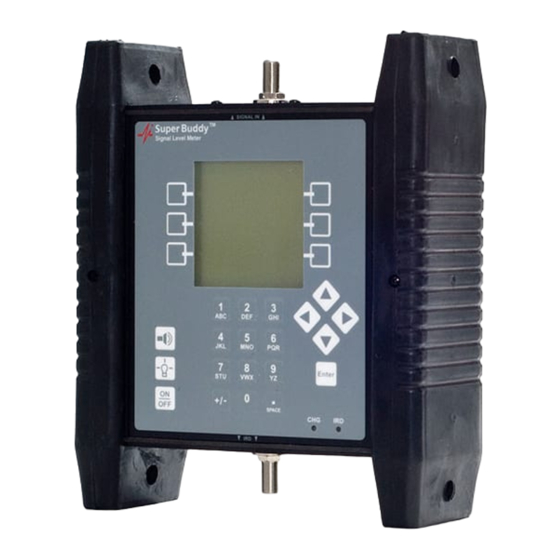
Advertisement
Quick Links
Application Note
10/26/2009
Limit Scan Feature
The Super Buddy™ Signal Level Meter includes a Limit Scan feature that performs a quick scan
of up to 5 transponders on a satellite, checks the values against pre-determined limits, and
provides a pass/fail indication. Use this test to quickly verify your installation against
recommended quality values.
Specifications
1) Up to 5 transponders per satellite may be tested
2) Up to 10 total satellites may be stored
3) Signal quality test (IRD signal quality number)
4) Signal level test
5) Signal quality limits defined for individual transponders
6) Signal level limit defined overall
7) Limits are changeable and are stored in the instrument
Setup
Use the normal meter setup for whatever type of system you are installing. When the installation
is complete, select "Limit Scan" from the main menu:
Advertisement

Summary of Contents for Applied Instruments Super Buddy Signal Level Meter
- Page 1 Application Note 10/26/2009 Limit Scan Feature The Super Buddy™ Signal Level Meter includes a Limit Scan feature that performs a quick scan of up to 5 transponders on a satellite, checks the values against pre-determined limits, and provides a pass/fail indication. Use this test to quickly verify your installation against recommended quality values.
- Page 2 Proof of Performance Testing with a Super Buddy™ Scanning The menu option will start the Limit Scan screen. If limits are already defined for the presently selected satellite, the scanning will start immediately. Note: The Limit Scan is only useful if the LNB is being powered by the meter. Press the LNB soft-key to power the LNB.
- Page 3 Proof of Performance Testing with a Super Buddy™ The following keys are active while scanning: EDIT – lets you edit the transponder list and limits (see below) SAVE – collects and stores a complete limit scan for upload to a PC LNB ON/OFF –...
- Page 4 Proof of Performance Testing with a Super Buddy™ you want to scan. Press the Enter key to move cursor to next field after typing in each desired value. You may edit the required IRD value for each transponder. These IRD values apply only to the selected satellite and specific transponder.
- Page 5 Proof of Performance Testing with a Super Buddy™ Preset Limits Note: At the present time, the soft key labeled "USE ZIP" is only usable for certain Dish Network satellites. For the USE ZIP soft key to be active, the service provider must send us the related files with their desired minimum IRD values and minimum Signal Level Limits (dBm) for each zip code.
- Page 6 Proof of Performance Testing with a Super Buddy™ If you use all 10 orbital slots, the system will not be able to create a list for any additional satellites and the following message will appear when you scroll to or activate a satellite that does not have limits defined: Limitations The transponder lists are stored simply by orbital position.
- Page 7 Proof of Performance Testing with a Super Buddy™ Page 7 of 10...
- Page 8 Proof of Performance Testing with a Super Buddy™ After the Limit Scan is complete, a screen will appear that allows you to type in the date, location, technician name or ID number, and any notes. Use the numeric keypad to fill in these fields and then press the SAVE soft-key.
- Page 9 Proof of Performance Testing with a Super Buddy™ If an error occurs during the copy process or if the flash storage area is too full, the message “Flash copy failed” will appear and the test data will be lost. There is file storage space for about 70 files. The actual limit depends on the number of transponders used.
- Page 10 Proof of Performance Testing with a Super Buddy™ It is recommended to select File/Properties/Results Only before printing Limit Scans to reduce the number of columns printed. Most field technicians do not need to or want to see the transponder parameters (modulation type, code rate, baud rate). Screenshots of the Properties settings change and the subsequent trimmed down Limit Scan results are shown below.







Need help?
Do you have a question about the Super Buddy Signal Level Meter and is the answer not in the manual?
Questions and answers